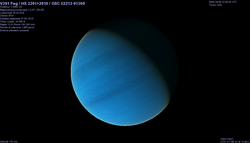Astronomy:V391 Pegasi b
| Discovery | |
|---|---|
| Discovered by | Silvotti et al. |
| Discovery site | Naples, Italy |
| Discovery date | March 2007 |
| Variable star timing | |
| Orbital characteristics | |
| 1.7 ± 0.1 AU (254,000,000 ± 15,000,000 km) | |
| Eccentricity | 0 |
| Orbital period | 1,170 ± 44 d |
| astron|astron|helion}} | 2,452,418 ± 96 |
| 23.5 ± 7.0 | |
| Semi-amplitude | 76.7 |
| Star | V391 Pegasi |
| Physical characteristics | |
| Mass | >3.2±0.7 |♃|J}}}}}} |
V391 Pegasi b, also known as HS 2201+2610 b, is an extrasolar planet candidate orbiting the star V391 Pegasi approximately 4,570 light-years away in the constellation of Pegasus. The candidate planet was discovered by means of variable star timing, which measured anomalies in variability of the star caused by a planet. It is the first planet candidate to claim to be detected with this method. The discovery reported the planet candidate to have mass of 3.2 times Jupiter's (assuming an edge-on orbit), semi-major axis of 1.7 AU, and orbital period of 1,170 days.
The planet candidate was discovered in March 2007 and published in September 2007. If it is confirmed, its survival would indicate that planets at Earth-like distances can survive their star's red-giant phase, though this is a much larger planet than Earth (about the same size as Jupiter and Saturn).[1] Its existence has been called into question with further monitoring of the pulsations of the star which show deviations from the predicted behavior if this were in fact a planet. The variations in the pulsations may be due to unknown stellar variability.[2]
References
- R. Silvotti; S. Schuh; R. Janulis; S. Bernabei; R. Ostensen; J.-E. Solheim; I. Bruni; R. Gualandi et al. (2007). "The O-C diagram of the subdwarf B pulsating star HS2201+2610: detection of a giant planet?". ASP Conference Series 372: 369. Bibcode: 2007ASPC..372..369S.
- R. Silvotti; S. Schuh; R. Janulis; J.-E. Solheim; S. Bernabei; R. Østensen; T. D. Oswalt; I. Bruni et al. (2007). "A giant planet orbiting the 'extreme horizontal branch' star V 391 Pegasi". Nature 449 (7159): 189–191. doi:10.1038/nature06143. PMID 17851517. Bibcode: 2007Natur.449..189S. https://authors.library.caltech.edu/17168/2/Silvotti2007p5743Nature_supp.pdf.
- ↑ Planet discovered that offers clues to Earth's future
- ↑ Silvotti, R.; Schuh, S.; Kim, S.-L.; Lutz, R.; Reed, M.; Benatti, S.; Janulis, R.; Lanteri, L. et al. (2018-03-01). "The sdB pulsating star V391 Peg and its putative giant planet revisited after 13 years of time-series photometric data" (in en). Astronomy & Astrophysics 611: A85. doi:10.1051/0004-6361/201731473. ISSN 0004-6361. Bibcode: 2018A&A...611A..85S.
External links
Coordinates: ![]() 22h 04m 12.2s, +26° 25′ 08″
22h 04m 12.2s, +26° 25′ 08″
 |


